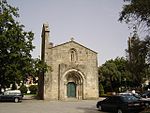Church of São Martinho de Cedofeita
National monuments in Porto DistrictRoman Catholic churches in PortoRomanesque architecture in Portugal

The Church of Cedofeita (Portuguese: Igreja de Cedofeita) is a medieval church in the civil parish of Cedofeita, municipality of Porto, in the northern Grande Porto Subregion of Portugal. The Church is a rare architectural example of a single-nave vaulted-ceiling temple, and the only one in the traditional Entre-Douro-e-Minho Province region of Portugal. It is classified as a National Monument.
Excerpt from the Wikipedia article Church of São Martinho de Cedofeita (License: CC BY-SA 3.0, Authors, Images).Church of São Martinho de Cedofeita
Largo do Priorado, Porto Cedofeita (Cedofeita, Santo Ildefonso, Sé, Miragaia, São Nicolau e Vitória)
Geographical coordinates (GPS) Address External links Nearby Places Show on map
Geographical coordinates (GPS)
| Latitude | Longitude |
|---|---|
| N 41.155791666667 ° | E -8.6216972222222 ° |
Address
Igreja de São Martinho de Cedofeita (Igreja de Cedofeita; Igreja da Cedofeita; Igreja Românica de Cedofeita; Igreja de São Martinho da Cedofeita; Igreja Paroquial da Cedofeita; Igreja de São Martinho)
Largo do Priorado
4050-466 Porto, Cedofeita (Cedofeita, Santo Ildefonso, Sé, Miragaia, São Nicolau e Vitória)
Portugal
Open on Google Maps








